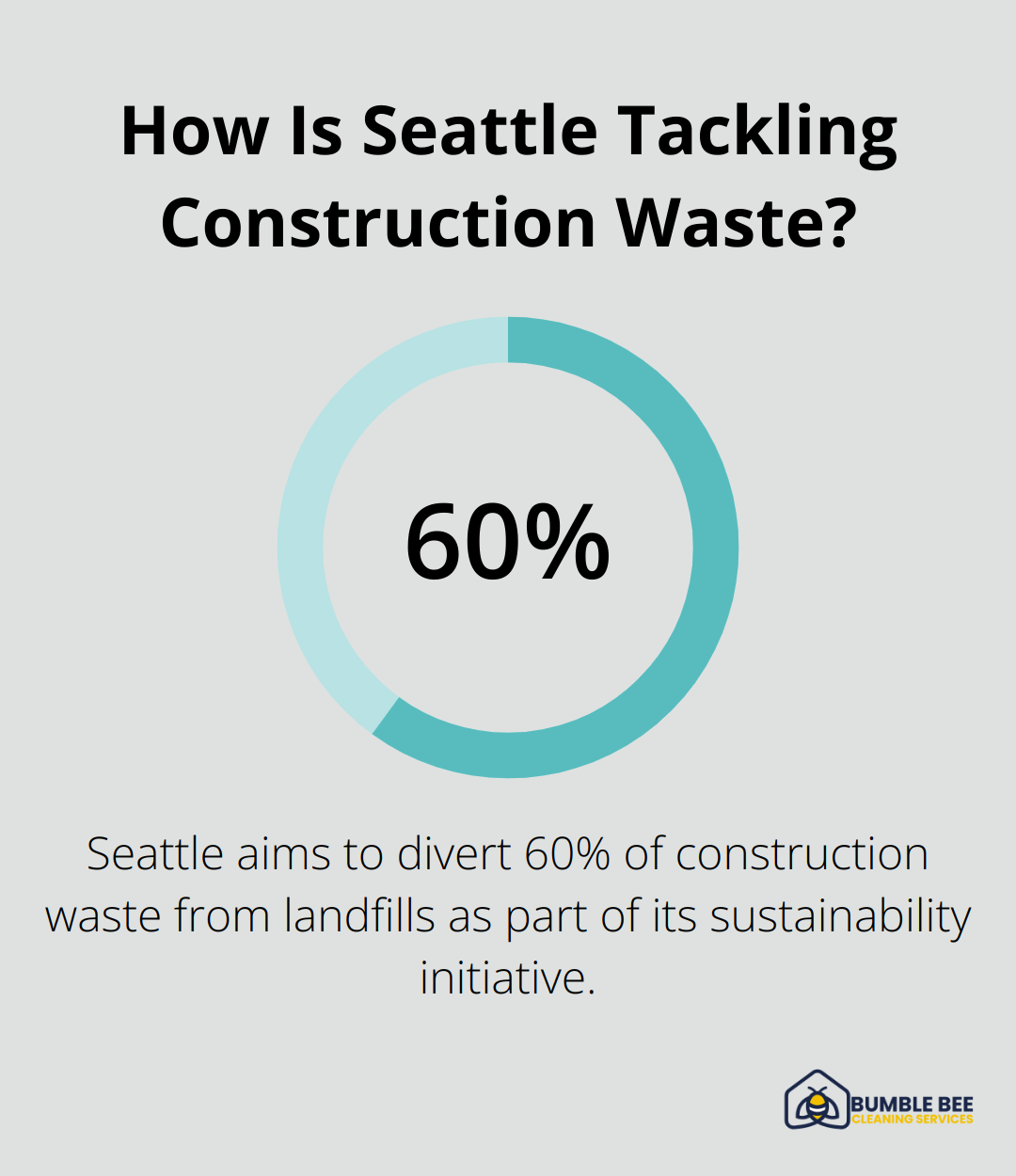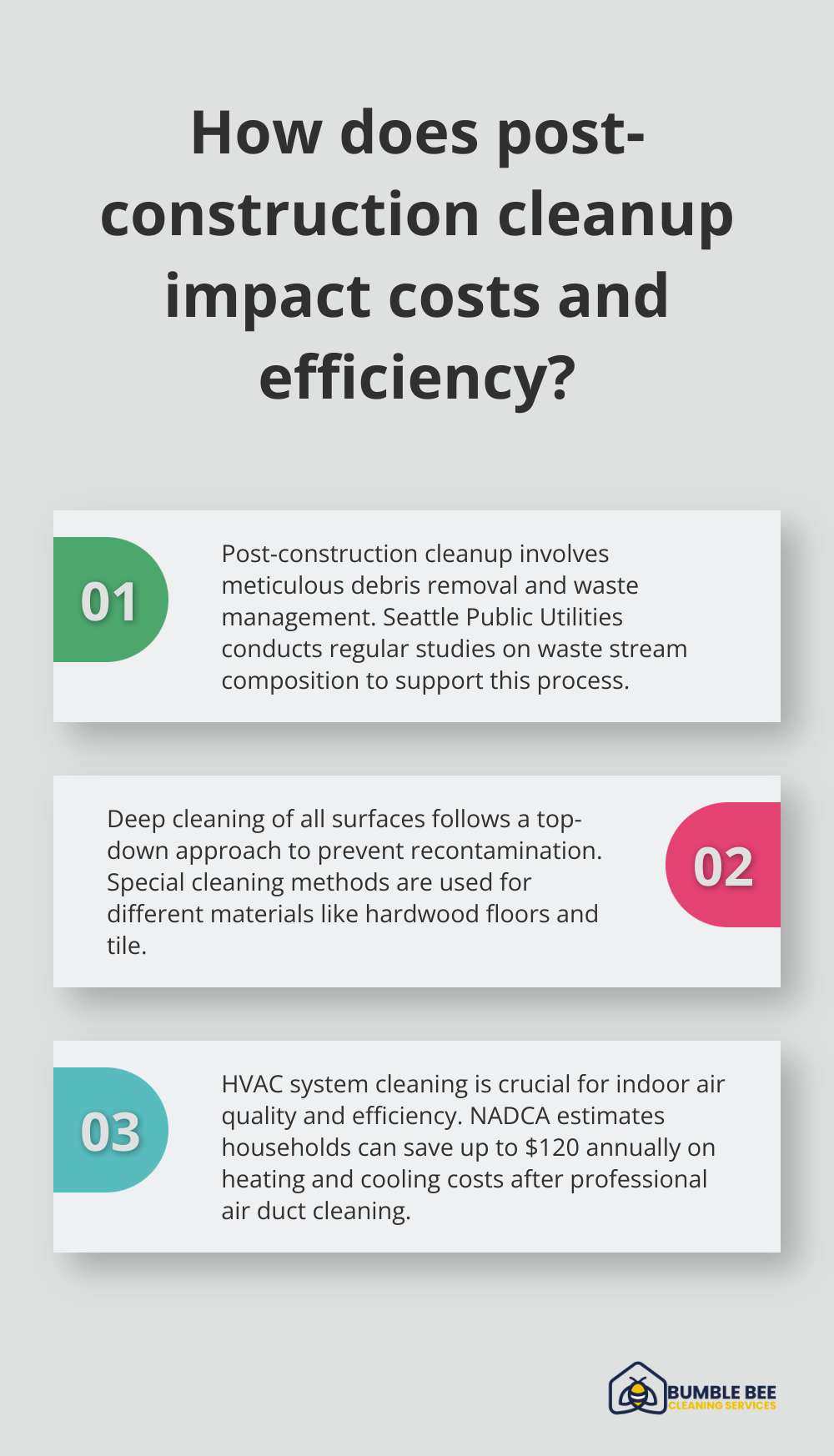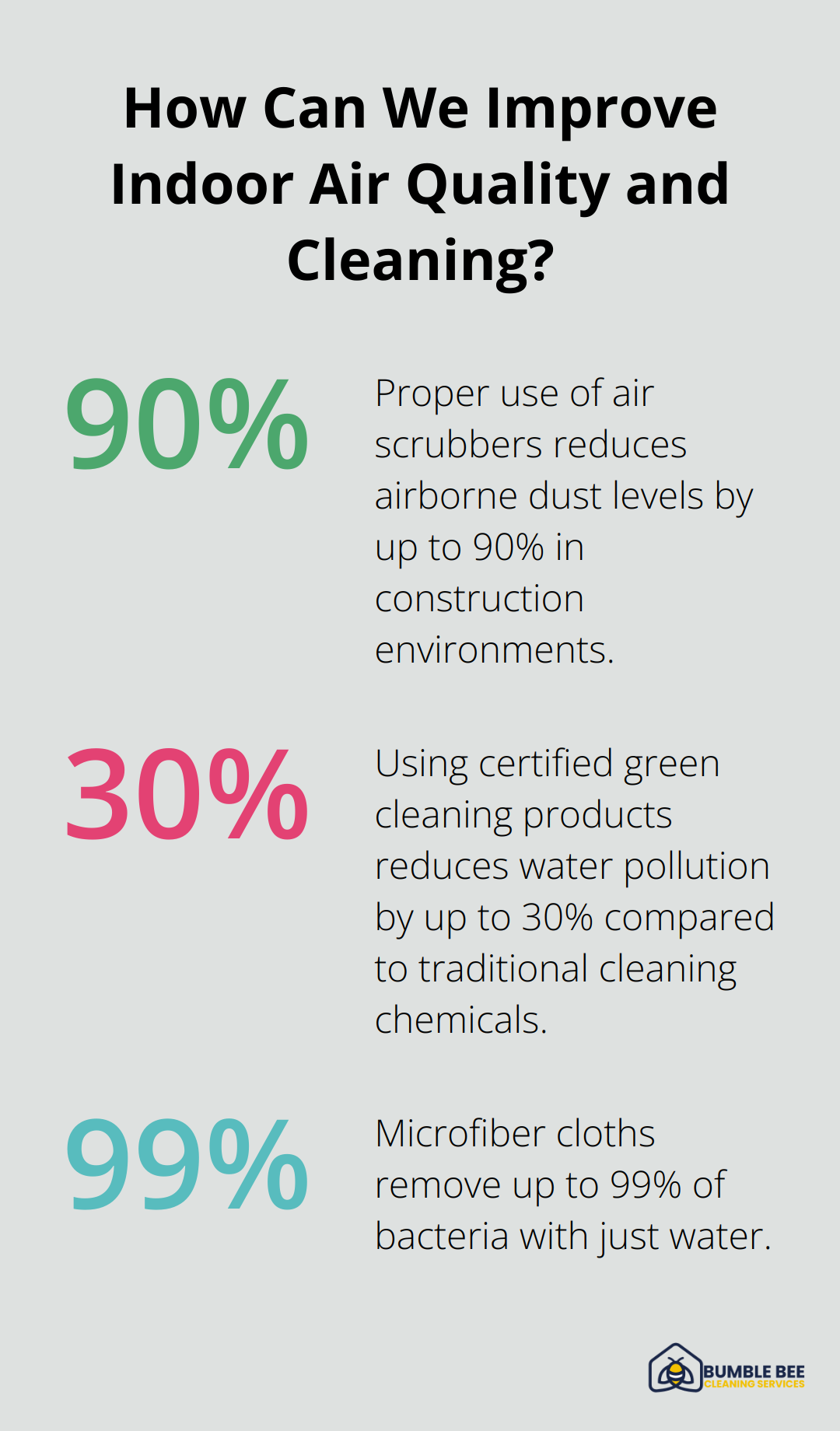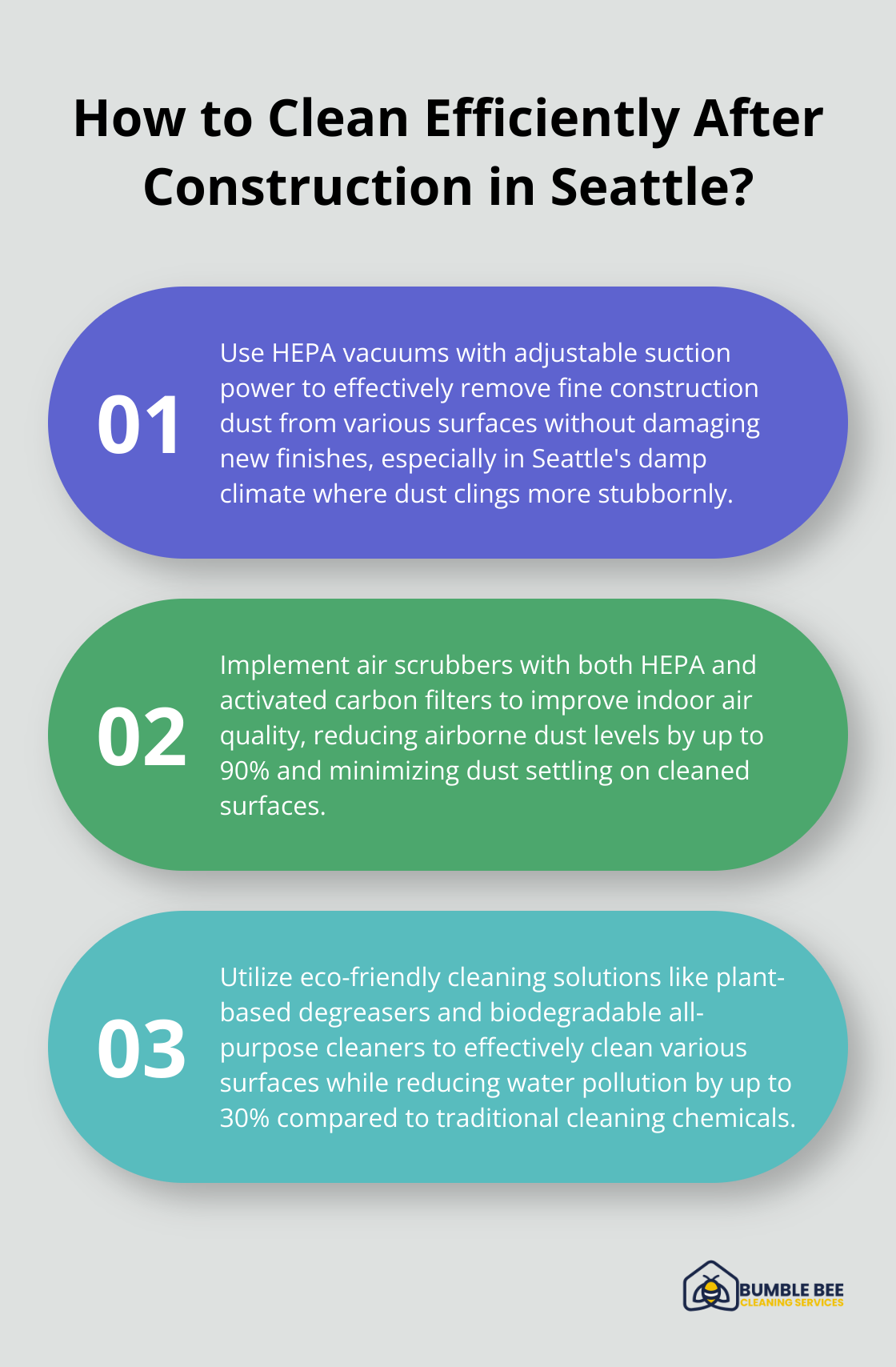Seattle’s construction industry is booming, with new construction projects reshaping the city’s skyline. At Bumble Bee Cleaning Services, we understand the unique challenges that come with post-construction cleanup in our rainy climate.
Proper cleaning after construction is not just about aesthetics; it’s crucial for safety and compliance with local regulations. In this guide, we’ll explore the best practices for post-construction cleaning in Seattle for 2024, helping you achieve a spotless finish for your newly built or renovated spaces.
Seattle’s Post-Construction Cleaning Challenges
The Impact of Seattle’s Climate on Cleaning
Seattle’s construction industry faces unique obstacles in post-construction cleaning. Seattle’s infamous rainfall creates unique challenges in post-construction cleaning. Water damage and moisture issues can lead to mold growth if not properly addressed.

The damp climate of Seattle significantly affects post-construction cleanup. Moisture in the air causes dust particles to adhere more stubbornly to surfaces, necessitating more intensive cleaning methods. This is particularly evident in newly constructed or renovated spaces where fine particulate matter from drywall, sawdust, and concrete can become deeply embedded in porous materials.
The National Weather Service reports that Seattle experiences an average of 152 rainy days per year. This high frequency of precipitation exposes construction sites to moisture, which leads to mud tracking and increased humidity levels indoors. Consequently, post-construction cleaning in Seattle requires specialized techniques and equipment to effectively remove all traces of construction debris.
Safety and Aesthetics: Beyond Appearances
Post-construction cleaning transcends visual appeal; it plays a critical role in ensuring the safety and health of future occupants. The Environmental Protection Agency (EPA) highlights that indoor air quality can suffer significantly from construction dust, which may contain harmful substances like silica, lead, or asbestos (especially in older building renovations).
Construction sites generate significant amounts of dust and particulate matter, which can negatively impact indoor air quality if not properly addressed. Proper cleaning mitigates these risks by removing potentially hazardous particles. It also prevents long-term damage to newly installed surfaces and fixtures. Fine dust can scratch hardwood floors or etch countertops if not properly removed, potentially leading to costly repairs or replacements.
Navigating Seattle’s Construction Cleanup Regulations
Seattle enforces stringent regulations governing construction site cleanup and waste management. The city aims to divert 60% of construction waste from landfills as part of its sustainability initiative, targeting zero waste by 2050. This goal necessitates careful sorting and disposal of construction debris during the cleaning process.
Cleaning professionals must familiarize themselves with these local regulations to ensure compliance. The Seattle Department of Construction and Inspections mandates that all construction sites maintain cleanliness to prevent the spread of dust and debris to neighboring properties. Non-compliance with these guidelines can result in fines and project delays.
Specialized Equipment for Seattle’s Unique Challenges
To address Seattle’s specific post-construction cleaning needs, specialized equipment becomes essential. High-powered HEPA vacuums effectively capture fine dust particles, while industrial-grade dehumidifiers help manage moisture levels in newly constructed spaces. Air scrubbers with activated carbon filters prove invaluable in removing airborne contaminants and odors associated with construction materials.
The use of this specialized equipment not only enhances the efficiency of the cleaning process but also contributes to improved indoor air quality. This approach aligns with Seattle’s commitment to green building practices and sustainable construction methods.
As we move forward, we’ll explore the essential steps involved in post-construction cleaning, detailing the best practices for tackling the unique challenges presented by Seattle’s construction landscape.
Mastering Post-Construction Cleanup
Post-construction cleanup requires meticulous attention to detail and a systematic approach. This critical phase transforms a construction site into a clean, safe, and welcoming space ready for occupancy.
Efficient Debris Removal and Waste Management
The first step in post-construction cleaning involves the removal of large debris. This process requires careful sorting of materials for recycling or disposal. Seattle Public Utilities conducts regular studies to provide statistically reliable data on the city’s waste stream composition. To address this, cleaning professionals implement rigorous sorting systems that align with Seattle’s zero waste goals.

Professional cleaning teams use industrial-grade equipment to clear the site efficiently. They employ heavy-duty brooms and shovels for larger debris, while HEPA-filtered vacuums capture fine particles. Special attention is paid to corners and crevices where debris often accumulates.
Deep Cleaning for Immaculate Surfaces
After the removal of bulk debris, the focus shifts to deep cleaning all surfaces. This includes walls, floors, fixtures, and ceilings. Cleaning experts use a top-down approach, starting with ceiling fans and light fixtures before moving to walls and floors. This method prevents recontamination of cleaned areas.
For walls, microfiber cloths and eco-friendly cleaning solutions effectively remove dust without damaging paint or wallpaper. Floors receive special treatment based on their material. Cleaners use pH-neutral solutions on hardwood floors to preserve their finish, while they scrub tile and grout with specialized cleaners to restore their original luster.
HVAC System Revitalization
The HVAC system often becomes a repository for construction dust and debris. Neglecting this component can lead to poor indoor air quality and reduced system efficiency. A thorough cleaning of all accessible ductwork and replacement of filters with high-efficiency models is essential.
The National Air Duct Cleaners Association (NADCA) estimates that the average household can save up to $120 annually on heating and cooling costs after a professional air duct cleaning. This finding underscores the importance of including HVAC cleaning in post-construction cleanup.
Crystal Clear Windows and Glass Surfaces
Windows and glass surfaces require special attention to achieve a streak-free finish. Commercial-grade glass cleaners and microfiber cloths remove stubborn construction residue effectively. For high-rise buildings, cleaning teams equip themselves with extension poles and safety harnesses to reach exterior windows safely.
The process extends beyond windows to include mirrors, glass partitions, and any other glass surfaces to ensure a sparkling clean finish throughout the space.
As we move forward, we’ll explore the specialized equipment and eco-friendly products that make post-construction cleaning in Seattle more effective and environmentally responsible.
Cutting-Edge Tools for Seattle’s Post-Construction Cleanup
HEPA Vacuums: The Foundation of Dust Control
HEPA (High-Efficiency Particulate Air) vacuums form the cornerstone of effective post-construction cleaning. These machines can theoretically remove at least 99.97% of dust, pollen, mold, bacteria, and any airborne particles with a size of 0.3 microns, which removes fine construction dust from air and surfaces. The EPA recommends HEPA filtration for maintaining indoor air quality, especially after renovation projects.

Seattle’s damp climate causes dust to cling more stubbornly to surfaces. Industrial-grade HEPA vacuums with adjustable suction power tackle this challenge effectively. These vacuums handle large debris and fine particles on various surfaces without damaging new finishes.
Air Scrubbers: Purifying Post-Construction Environments
Air scrubbers improve indoor air quality after construction. These portable filtration systems remove contaminants and circulate clean air back into the space. In Seattle’s humid environment, air scrubbers with both HEPA and activated carbon filters prove most effective. These industrial-grade air scrubbers create a controlled airflow that prevents dust from spreading to unaffected areas of the home during the cleaning process.
The National Institute for Occupational Safety and Health (NIOSH) reports that proper use of air scrubbers reduces airborne dust levels by up to 90% in construction environments. This reduction improves air quality and minimizes dust settling on cleaned surfaces (which reduces the need for repeated cleaning).
Eco-Friendly Cleaning Solutions: A Seattle Necessity
Seattle’s commitment to sustainability extends to post-construction cleaning practices. Eco-friendly cleaning solutions often become a requirement, especially in projects seeking green building certifications. These products clean effectively on various surfaces while minimizing environmental impact.
Plant-based degreasers remove construction adhesives and oils without harsh chemicals. Biodegradable all-purpose cleaners tackle general dirt and grime on most surfaces. For tougher jobs (like removing concrete residue), eco-friendly alternatives to muriatic acid offer similar effectiveness without environmental hazards.
The Green Seal organization reports that using certified green cleaning products reduces water pollution by up to 30% compared to traditional cleaning chemicals. This statistic holds particular relevance in Seattle, where protecting local water bodies remains a top priority.
Innovative Tools for Challenging Areas
Post-construction cleaning often involves reaching difficult areas or dealing with delicate finishes. Extendable dusters with microfiber heads allow cleaners to reach high ceilings and corners without scaffolding. For cleaning newly installed windows, water-fed pole systems provide streak-free results while allowing cleaners to remain safely on the ground.
Microfiber mops and cloths prove essential for delicate surfaces like newly installed hardwood floors or marble countertops. These tools trap dust and debris effectively without scratching surfaces. The Cleaning Industry Research Institute states that microfiber cloths remove up to 99% of bacteria with just water, which reduces the need for harsh chemicals on sensitive surfaces.
Seattle’s construction landscape often features innovative designs that create unique cleaning challenges. Adaptability becomes key. Telescopic cleaning poles with interchangeable heads allow for customized approaches to different surfaces and spaces, ensuring a thorough clean in even the most architecturally complex buildings.
Final Thoughts
Post-construction cleaning in Seattle presents unique challenges due to the city’s climate and environmental regulations. Effective cleanup requires specialized equipment, eco-friendly products, and expert knowledge to achieve a thorough clean. Professional post-construction cleaning services improve indoor air quality, protect newly installed surfaces, and ensure compliance with local regulations.

Experienced and certified cleaning professionals are essential for new construction projects. Bumble Bee Cleaning Services brings expertise to post-construction cleaning in Seattle, employing cutting-edge techniques and eco-friendly products. Our team understands the intricacies of cleaning various surfaces and materials used in modern construction.
Professional cleaning services create healthier environments for occupants and extend the lifespan of building materials. As Seattle continues to grow, proper post-construction cleaning remains an essential step in the construction process. It bridges the gap between completion and occupancy, ensuring new spaces are visually appealing, safe, and healthy for their intended use.
